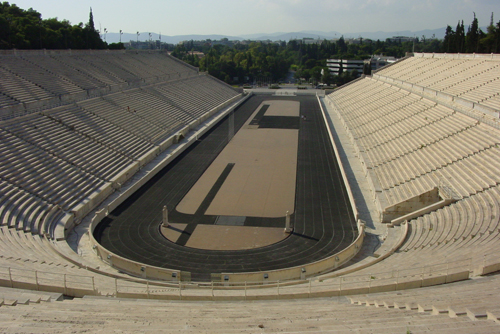With all eyes turned to the 2016 Olympic Games in Rio, DAVID ADAMS looks at the origins and evolution of the modern Olympic Games…

Following on from last week’s look at the origins of the ancient Olympics, this week we take a look at how the modern Olympics came about.
The modern Olympics owe their origins in large part to 19th Frenchman, Baron Pierre de Coubertin, who wasn’t the first to try and revive the ancient Games but who was the first to do so successfully.

WHERE IT ALL BEGAN: The Panathenaic Stadium where the athletic events of the 1896 Games were held in Athens, Greece. PICTURE: Tim Rogers/www.freeimages.com
Inspired by the discovery of the ancient remains of the Games infrastructure at Mt Olympus in Greece, in 1894 he founded the International Olympic Committee in Paris to turn what had been a dream into a reality.
The first Games of the modern era were held in Athens 1896 with 241 participants from 14 nations. In an illustration of the growth of the Games, more than 10,000 athletes have gathered in Rio de Janeiro for the 2016 Games, representing 205 countries.
The athletes were for many years only allowed to be amateurs in line with the wishes of de Coubertin but this rule was abolished by the IOC in 1984 in time for the Los Angeles Games and professional athletes have been taking part ever since.
There were no women competitors at the first games; they made their Olympic debut at the 1900 Games in Paris in the sports of tennis and golf and the program of events women have been able to compete in has been gradually expanded until the 2012 Games in London, when the introduction of women’s boxing means women were able to compete in every sport on the program.
The program of sports in which competitors took part grown considerably over the years from the nine sports first included on the program: athletics, cycling, fencing, gymnastics, weightlifting, wrestling, swimming (the first events were held in the sea and rivers), tennis and shooting. The Rio Olympics boasts more than 42 sports, representing 306 events.
There have been some rather odd sports included in the Olympic program over the years – including everything from live pigeon shooting to club swinging and a swimming obstacle course event – and even, from 1912 to 1948, architecture, sculpture, painting and literature competitions. The Games have also hosted what are called ‘demonstration sports’ – these have included Australian Rules football (at the 1956 Games in Melbourne), bowling (as the 1988 Games in Seoul), and Basque pelota, roller hockey and taekwondo (as the 1992 Games in Barcelona).
The Games today are held over a period of no more than 16 days in contrast to the five days of the ancient Olympics. They include opening and closing ceremonies and a torch relay with the latter first held at the Games in Germany in 1936.
The idea of the Olympic Village in which the athletes stay has its origins in the 1932 Games in Los Angeles; before that athletes stayed in hotels, hostels, schools and even boats.
Meanwhile, the first Winter Olympics, known initially as an International Winter Sports Week, were held in Chamonix in France in 1924 in response to the growing popularity of snow sports.





